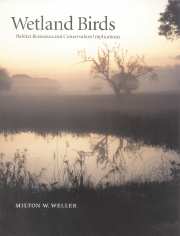Book contents
- Frontmatter
- Contents
- List of plates
- Preface
- Acknowledgments
- 1 Introduction
- 2 Wetlands: what, where, and why
- 3 Major groups of birds that use wetlands
- 4 Water and other resource influences
- 5 Foods, feeding tactics, strategies, and guilds
- 6 Bird mobility and wetland predictability
- 7 Other behavioral and physical influences on wetland living
- 8 Spatial and structural patterns
- 9 Habitat dynamics: water, plant succession, and time
- 10 Population consequences of wetland abundance and quality
- 11 How birds influence wetlands
- 12 Conservation implications
- 13 Measures of bird habitat use and quality
- 14 Current status and some conservation problems
- 15 Conservation and management strategies
- 16 Outlook
- 17 Epilogue
- Appendix 1 Scientific names of birds and bird groups
- Appendix 2 Scientific names of animals and animal groups other than birds
- Appendix 3 Scientific names of plants and plant groups
- Index of birds and bird groups
- Subject index
7 - Other behavioral and physical influences on wetland living
Published online by Cambridge University Press: 02 October 2009
- Frontmatter
- Contents
- List of plates
- Preface
- Acknowledgments
- 1 Introduction
- 2 Wetlands: what, where, and why
- 3 Major groups of birds that use wetlands
- 4 Water and other resource influences
- 5 Foods, feeding tactics, strategies, and guilds
- 6 Bird mobility and wetland predictability
- 7 Other behavioral and physical influences on wetland living
- 8 Spatial and structural patterns
- 9 Habitat dynamics: water, plant succession, and time
- 10 Population consequences of wetland abundance and quality
- 11 How birds influence wetlands
- 12 Conservation implications
- 13 Measures of bird habitat use and quality
- 14 Current status and some conservation problems
- 15 Conservation and management strategies
- 16 Outlook
- 17 Epilogue
- Appendix 1 Scientific names of birds and bird groups
- Appendix 2 Scientific names of animals and animal groups other than birds
- Appendix 3 Scientific names of plants and plant groups
- Index of birds and bird groups
- Subject index
Summary
Territories and home ranges
At some time in the life cycle, most birds seem to space themselves by means of habitat selection and behavior. Within the home range, depending on time of year and functional need, many species of birds have a well-defined breeding or feeding territory that is defended by singing, calling, and/or aggressive chases; some waterbirds also defend stopover sites during migration and winter territories. The origins and advantages of such behavior has been discussed by many workers, and include resource protection, foraging efficiency, predator defense, population regulation, competitive advantage, and energy efficiency (Anderson and Titman 1992, Ashmole 1971, Orians 1971). Many waterbirds are highly social in breeding and feeding, and although territories may be clear-cut and violently defended, there is a wide range of territory size and behavior among wetland birds. While there is a positive relationship between body size and territory size in birds (Schoener 1968), it also seems to be dependent upon nesting and feeding strategies. Defense of territories that incorporate most life functions, such as mating, nesting, and feeding (see classification in Pettingill 1970), is most common among species that for reasons of food supply, water access, or nest cover restrict themselves to small but diverse patches and move little during the breeding period, e.g., some grebes and loons (Bergman and Derksen 1977), or coots (Gullion 1953). Species that nest colonially, such as egrets, herons, ibises, cormorants and pelicans, commonly defend only a small area of the tree, shrub, or marsh vegetation or substrate that is a mating site as well as nest site.
- Type
- Chapter
- Information
- Wetland BirdsHabitat Resources and Conservation Implications, pp. 99 - 120Publisher: Cambridge University PressPrint publication year: 1999



